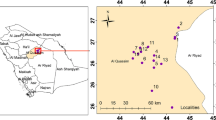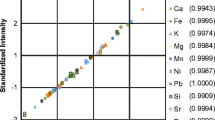Abstract
In this paper the performances and the limitations of three multi-elementary analysis techniques are compared applied to a study of air pollution biomonitoring in Morocco. These techniques are: (1) 14 MeV neutron activation analysis (14 MeV-NAA), (2) thermal neutron activation analysis using the k 0 quasi-absolute method (k 0-NAA) and (3) energy dispersive X-ray fluorescence analysis (ED-XRF). The experimental procedures and the control of the analytical results using certified reference materials are described and discussed. The three methods were confronted for the analysis of lichens, mosses and tree-barks. The complementarity of these methods enabled us to determine 43 elements in different samples. The most suitable method for each element was selected according to the sensitivity and selectivity necessitating the minimum corrections of the matrix effects and/or the interfering reactions.
Similar content being viewed by others
References
M. DE BRUIN, Bulletin de l'AIEA, Vol. 32, No. 4 (1990) 22.
M. C. FREITAS, A. S. NOBRE, J. Radioanal. Nucl. Chem., 217 (1997) 17.
P. KUIK, H. T. WOLTERBEEK, Water, Air Soil Pollut., 84 (1995) 323.
G. REVEL, S. AYRAULT, J. Radioanal Nucl. Chem., 244 (2000) 73.
A. SENHOU, A. CHOUAK, M. BERRADA, M. LFERDE, JMSTA, Octobre 1999, Meknes, Morocco.
M. BORMAN, Handbook on Nuclear Activation Cross-Section, Technical Reports Series, No. 156, IAEA, Vienna, Austria, 1974.
Z. BöDY, J. CSIKAI, Handbook on Nuclear Activation Data, Technical Reports Series, No. 273, IAEA, Vienna, Austria, 1987.
U. REUS, W. WESTMEIER, Atomic Data and Nuclear Data Tables, Vol. 29, No. 1, Academic Press, Germany, 1983.
D. PICCOT, C. DESCHAMPS, R. DELMAS, G. REVEL, J. Radioanal. Nucl. Chem., 215, (1997) 263.
P. VAN-ESPEN, Nucl. Instr. Meth., 142 (1977) 243.
M. BOUNAKHLA, Thèse de Doctorat d'Etat, Université Ibn Tofail, Kénitra, Maroc, 1998.
A. MARKOWICZ, X-ray Spectrom., 8 (1979) No. 1.
J. LEROUX, M. MAHMUD, Anal. Chem., 38 (1966) 76.
E. STEINNES, A. RüHLING, H. LIPPO, A. MäKINEN, Reference Materials for Large-scale Metal Deposition Surveys, Accred. Qual. Assur, 2 (1997) 243, Springer-Verlag, Norway.
IAEA, Trace and Minor Elements in Lichen, Analytical Duality Control Service, IAEA, Vienna, Austria, 1999.
Author information
Authors and Affiliations
Rights and permissions
About this article
Cite this article
Senhou, A., Chouak, A., Cherkaoui, R. et al. Comparison of 14 MeV-NAA, k0-NAA and ED-XRF for air pollution bio-monitoring. Journal of Radioanalytical and Nuclear Chemistry 253, 247–252 (2002). https://doi.org/10.1023/A:1019697725334
Issue Date:
DOI: https://doi.org/10.1023/A:1019697725334




